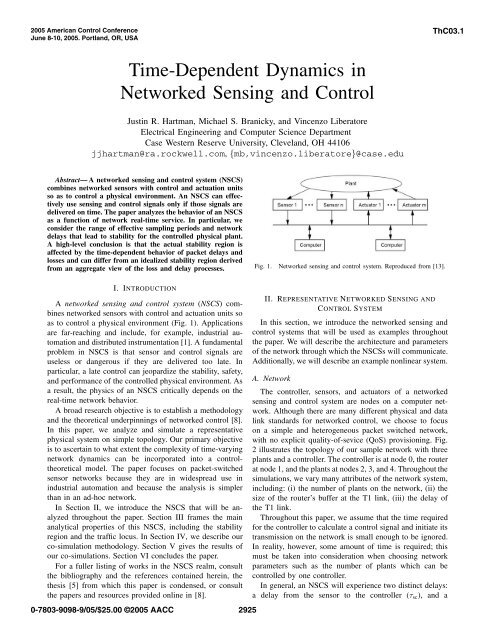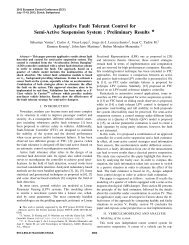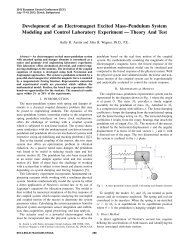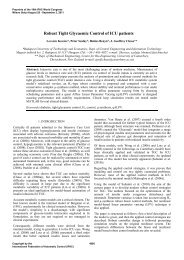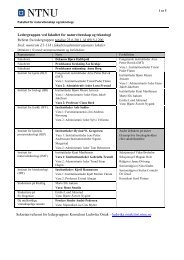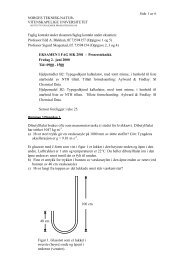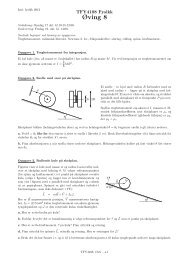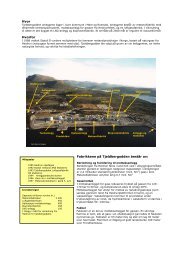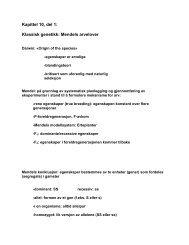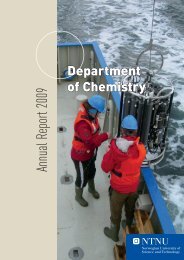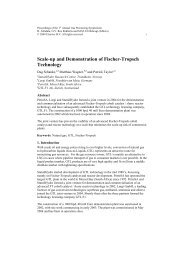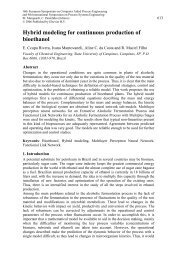You also want an ePaper? Increase the reach of your titles
YUMPU automatically turns print PDFs into web optimized ePapers that Google loves.
2005 American Control Conference<br />
June 8-10, 2005. Portland, OR, USA<br />
Time-Dependent Dynamics in<br />
Networked Sensing and Control<br />
Justin R. Hartman, Michael S. Branicky, and Vincenzo Liberatore<br />
Electrical Engineering and Computer Science Department<br />
Case Western Reserve University, Cleveland, OH 44106<br />
jjhartman@ra.rockwell.com, {mb,vincenzo.liberatore}@case.edu<br />
Abstract— A networked sensing and control system (NSCS)<br />
combines networked sensors with control and actuation units<br />
so as to control a physical environment. An NSCS can effectively<br />
use sensing and control signals only if those signals are<br />
delivered on time. The paper analyzes the behavior of an NSCS<br />
as a function of network real-time service. In particular, we<br />
consider the range of effective sampling periods and network<br />
delays that lead to stability for the controlled physical plant.<br />
A high-level conclusion is that the actual stability region is<br />
affected by the time-dependent behavior of packet delays and<br />
losses and can differ from an idealized stability region derived<br />
from an aggregate view of the loss and delay processes.<br />
I. INTRODUCTION<br />
A networked sensing and control system (NSCS) combines<br />
networked sensors with control and actuation units so<br />
as to control a physical environment (Fig. 1). Applications<br />
are far-reaching and include, for example, industrial automation<br />
and distributed instrumentation [1]. A fundamental<br />
problem in NSCS is that sensor and control signals are<br />
useless or dangerous if they are delivered too late. In<br />
particular, a late control can jeopardize the stability, safety,<br />
and performance of the controlled physical environment. As<br />
a result, the physics of an NSCS critically depends on the<br />
real-time network behavior.<br />
A broad research objective is to establish a methodology<br />
and the theoretical underpinnings of networked control [8].<br />
In this paper, we analyze and simulate a representative<br />
physical system on simple topology. Our primary objective<br />
is to ascertain to what extent the complexity of time-varying<br />
network dynamics can be incorporated into a controltheoretical<br />
model. The paper focuses on packet-switched<br />
sensor networks because they are in widespread use in<br />
industrial automation and because the analysis is simpler<br />
than in an ad-hoc network.<br />
In Section II, we introduce the NSCS that will be analyzed<br />
throughout the paper. Section III frames the main<br />
analytical properties of this NSCS, including the stability<br />
region and the traffic locus. In Section IV, we describe our<br />
co-simulation methodology. Section V gives the results of<br />
our co-simulations. Section VI concludes the paper.<br />
For a fuller listing of works in the NSCS realm, consult<br />
the bibliography and the references contained herein, the<br />
thesis [5] from which this paper is condensed, or consult<br />
the papers and resources provided online in [8].<br />
0-7803-9098-9/05/$25.00 ©2005 AACC<br />
2925<br />
Fig. 1. Networked sensing and control system. Reproduced from [13].<br />
II. REPRESENTATIVE NETWORKED SENSING AND<br />
CONTROL SYSTEM<br />
<strong>ThC03.1</strong><br />
In this section, we introduce the networked sensing and<br />
control systems that will be used as examples throughout<br />
the paper. We will describe the architecture and parameters<br />
of the network through which the NSCSs will communicate.<br />
Additionally, we will describe an example nonlinear system.<br />
A. Network<br />
The controller, sensors, and actuators of a networked<br />
sensing and control system are nodes on a computer network.<br />
Although there are many different physical and data<br />
link standards for networked control, we choose to focus<br />
on a simple and heterogeneous packet switched network,<br />
with no explicit quality-of-sevice (QoS) provisioning. Fig.<br />
2 illustrates the topology of our sample network with three<br />
plants and a controller. The controller is at node 0, the router<br />
at node 1, and the plants at nodes 2, 3, and 4. Throughout the<br />
simulations, we vary many attributes of the network system,<br />
including: (i) the number of plants on the network, (ii) the<br />
size of the router’s buffer at the T1 link, (iii) the delay of<br />
the T1 link.<br />
Throughout this paper, we assume that the time required<br />
for the controller to calculate a control signal and initiate its<br />
transmission on the network is small enough to be ignored.<br />
In reality, however, some amount of time is required; this<br />
must be taken into consideration when choosing network<br />
parameters such as the number of plants which can be<br />
controlled by one controller.<br />
In general, an NSCS will experience two distinct delays:<br />
a delay from the sensor to the controller (τsc), and a
Fig. 2. Network topology with three plants.<br />
delay from the controller to the actuator (τca). Each can<br />
be analyzed using Eqs. (10) and (11) to find the bounds in<br />
which the the sensor-to-controller or controller-to-actuator<br />
delay will remain. Figure 3 illustrates the timing of the<br />
packets on an NSCS, including the sensor-to-controller and<br />
controller-to-actuator delays.<br />
Fig. 3. Delay timing diagram for an NSCS. Reproduced from [14].<br />
location, with motion to the right being positive). For more<br />
details about the inverted pendulum, including Matlab code,<br />
see [3], [9], [11].<br />
Fig. 4. Cartoon of inverted pendulum system. Modified from [11].<br />
Once the system has been linearized, we can express it<br />
in state-space form, as in Eq. (2).<br />
⎡ δx<br />
δt<br />
δ ˙x<br />
⎢ δt<br />
⎣ δφ<br />
δt<br />
δ ˙ ⎤ ⎡<br />
0 1 0 0<br />
⎥ ⎢ 0 0 0 0<br />
⎦ = ⎣ 0 0 0 1<br />
φ<br />
3g<br />
0 0<br />
δt<br />
4L − 3BR 4ML2 ⎤ ⎡ ⎤ ⎡<br />
x 0<br />
⎥ ⎢ ˙x ⎥ ⎢ 1<br />
⎦ ⎣ φ ⎦ + ⎣ 0<br />
˙φ − 3<br />
⎤<br />
⎥<br />
⎦ u.<br />
4L<br />
(2)<br />
When we sample a continuous-time system with a constant<br />
sampling period h, the resulting discrete-time system<br />
can be described by<br />
where<br />
x [k +1]=Φx [k]+Γu [k] , (3)<br />
Φ=e Ah , Γ=<br />
h<br />
0<br />
e As ds B. (4)<br />
Assuming the full state is available through sensors,<br />
a linear controller of the form u[k] = −Kx[k] can be<br />
designed to meet stability or performance objectives of the<br />
the overall, closed-loop system:<br />
x [k +1]=Φx [k] − ΓKx[k] =(Φ− ΓK)x [k] . (5)<br />
B. Control System<br />
We introduce and describe the system which will be used<br />
as an example: an inverted pendulum. It consists of a single<br />
point mass on the end of a rod, swinging freely from a cart<br />
on a track. Fig. 4 presents a cartoon of this system. The<br />
equations of motion for the inverted pendulum are:<br />
¨φ + 3BR<br />
4ML2 ˙ φ − 3g<br />
There are well-known methods (pole placement, LQR, etc.)<br />
thatmaybeusedtodesignK [4]. In this paper, we will<br />
primarily be concerned with the case where K is chosen<br />
such that the closed-loop system matrix Φ − ΓK is Schur<br />
(i.e., all its eigenvalues have magnitude less than one).<br />
3<br />
sin φ = − ¨x, (1)<br />
4L 4L<br />
where BR is the coefficient of friction of the pivot joint, M<br />
is the mass of the weight at the end of the rod, L is the length<br />
of the rod, and g is the gravitational constant. The input<br />
(control signal, u) to the cart-mass system is the acceleration<br />
¨x = u of the cart, and the outputs are the angle of the<br />
pendulum, φ (as measured from the “up” vertical position,<br />
with clockwise rotation being positive), and the position of<br />
III. ANALYSIS<br />
A. Constant Network Delays<br />
For networked sensing and control systems with fixed<br />
delays, we can analyze the system by reformulating the<br />
system matrices. Since the actuation of the system occurs at<br />
some time τ after the controller has calculated the control<br />
signal, we must revise the system model to account for<br />
this delay. For delays less than one sampling period, and<br />
assuming a constant sampling period h, we can model the<br />
system as follows [4]:<br />
the cart on the track, x (as measured from an arbitrary zero x [k +1]=Φx [k]+Γ0 (τ) u [k]+Γ1 (τ) u [k − 1] , (6)<br />
2926
where<br />
Φ=e Ah h−τ<br />
, Γ0 (τ) = e As h<br />
Bds, Γ1 (τ) =<br />
0<br />
h−τ<br />
e As B ds.<br />
(7)<br />
By augmenting the system state space with the previous<br />
control signal value, we obtain ˜x [k +1]= Øx [k]+ ˜ Bu[k] ,<br />
where<br />
à =<br />
Φ Γ1<br />
0 0<br />
<br />
, ˜ B =<br />
Γ0<br />
1<br />
L∈L<br />
<br />
, ˜x [k] =<br />
<br />
x [k]<br />
u [k − 1]<br />
<br />
.<br />
(8)<br />
The delay for all packets in transit on the links in L will be<br />
bounded by [τmin,τmax].<br />
C. Varying Delay and Effective Sampling Period<br />
The effective sampling period of an NSCS is the average<br />
sampling period of the NSCS over a period of time, taking<br />
into account all of the packet losses:<br />
th<br />
heff (t) = , (12)<br />
t − hd (t)<br />
where h is the nominal sampling period in seconds, and<br />
d (t) is the total number of packets belonging to the plant<br />
under observation dropped before time t.<br />
If all the packets dropped on a link are due to oversaturation<br />
of the network, then we can use aprioriknowl edge of the network topology, link speeds, sampling periods,<br />
and data packet sizes to calculate the rate, r, at which control<br />
packets will be transmitted:<br />
<br />
ηL<br />
r =min , 1 , (13)<br />
8ET<br />
The stability of the system in Eq. (5) in an NSCS setting,<br />
sampled periodically with period h and subject to fixed<br />
delay τ, can be assessed by testing the Schur-ness of the<br />
matrix<br />
à − ˜ B [K 0] . (9)<br />
For delays greater than one sampling period, a similar<br />
process of augmenting the state space with more delayed<br />
control signals (e.g. u[k − 2], ..., u[k − n]) can be used. For<br />
a fuller treatment of these techniques, see [13], [4].<br />
In special cases (e.g., scheduled, no-collision transmissions<br />
on a private network), these methods are applicable.<br />
However, in NSCS involving the Internet, delays are in<br />
general unpredictable [6].<br />
B. Network Bottlenecks<br />
Two of the primary difficulties in the analysis and design<br />
of networked sensing and control systems are packet loss<br />
and transmission delays. Some amount of delay is inherent<br />
in the data transmission across a network, and does not<br />
change; the portion of network-induced delay which can<br />
vary, as well as the phenomena of packet losses, are a<br />
result of collisions and queuing at intermediate nodes on<br />
a network. We investigate the primary causes of data loss<br />
and delay here.<br />
In network devices (routers, switches, and hubs), the<br />
size of the link storage buffer is configurable. Hence, the<br />
maximum delay possible of an NSCS packet (traveling over<br />
asetofLlinks from source to destination) is directly related<br />
to the size of the link buffers:<br />
τmax = <br />
<br />
δL +<br />
L∈L<br />
8P (βL<br />
<br />
+1)<br />
,<br />
ηL<br />
(10)<br />
where δL is the fixed link delay of link L, P is the packet<br />
size in bytes, βL is the buffer size of link L in number of<br />
packets, and ηL is the link speed of link L in bits per second.<br />
(We assume for simplicity that all packets have the same size<br />
P . If the buffer size is expressed in bytes rather than the<br />
number of packets, one can simply use the packet size P<br />
to determine βL.) Eq. (10) predicts that the maximum link<br />
delay increases with the buffer size. Of course, a smaller<br />
buffer also implies a larger number of packet losses.<br />
The minimum delay for a network path is<br />
τmin = <br />
<br />
δL + 8P<br />
where ηL is the link speed of the bottleneck link (in bits per<br />
second), and ET is the number of bytes expected to arrive<br />
at the bottleneck link during one second of operation. For<br />
periodic traffic sources, we can replace ET in Eq. (13) with<br />
asum:ET =<br />
<br />
. (11)<br />
ηL<br />
Si<br />
i∈N hi ,whereSiisthesize of the periodic<br />
packet from the ith node (in bytes), hi is the transmission<br />
period of the ith node, and N is the set of all periodic nodes<br />
on the network.<br />
Thus, given an expected usage pattern of the network, including<br />
all NSCSs and other regular periodic traffic sources,<br />
one can calculate an expected value of the transmission rate.<br />
Further, if we are given the transmission rate r, we can also<br />
calculate the effective sampling period, heff:<br />
heff = h<br />
r =max<br />
<br />
8h i∈N<br />
ηL<br />
<br />
Si<br />
hi ,h , (14)<br />
where h is the sampling period for which the plant was<br />
designed.<br />
D. Sampling Period and Delay Stability Region<br />
For an ideal networked sensing and control system with<br />
no data loss and fixed delays, we can derive bounds on the<br />
sampling period and delay under which the system remains<br />
stable. By varying the sampling period and the constant<br />
delay of the system and testing the stability of the resulting<br />
system matrix (see Eq. (9)), we can plot the boundary of a<br />
region of stability, which we call the sampling period and<br />
delay stability region (SPDSR). This idea was developed<br />
by Zhang et al. in [14], [13]; a generalized algorithm<br />
for discovering the SPDSR given continuous-time system<br />
matrices and a discrete-time feedback matrix is given in<br />
[5].<br />
2927
E. Traffic Locus<br />
A traffic locus is a locus of points describing, in the same<br />
sampling period and delay space as the stability regions,<br />
the theoretically possible points of effective sampling period<br />
and network-induced delay for a single plant, as a function<br />
of the amount of traffic on the network.<br />
At all times, the packet delays on a network will be<br />
bounded by [τmin,τmax] from Eqs. (10) and (11). As long<br />
as the amount of traffic remains below the bandwidth of the<br />
network, the effective sampling period of a plant will be<br />
its actual sampling period, and the delay will remain fixed<br />
at τmin. However, once the amount of traffic exceeds the<br />
network bandwidth, the delay will remain fixed at τmax and<br />
the effective sampling period will increase. For networks<br />
where all nodes are periodic traffic sources, we can express<br />
the traffic locus as<br />
T (heff) =<br />
τmin<br />
h eff , for heff = h,<br />
τmax<br />
h eff , for heff >h,<br />
(15)<br />
where h is the sampling period for which the plant was<br />
designed, and heff can be calculated from Eq. (14) for<br />
different amounts of network traffic.<br />
IV. CO-SIMULATION METHODOLOGY<br />
A. Network<br />
In order to simulate a networked sensing and control<br />
system, the simulation of the dynamics of the state-space<br />
equations of a control system was combined with the simulation<br />
of a network topology into a single ns-2 simulation<br />
script. This script utilizes the network components of ns-2<br />
to simulate network dynamics, such as the transmission,<br />
queuing, forwarding, and receipt of packets, as well as<br />
any network cross-traffic, such as FTP flows; the script<br />
also utilizes the Agent/Plant extension [2], [7] to simulate<br />
the sampling, control, and actuation of the control system<br />
components. The dynamics of each plant were simulated<br />
inline by first-order Euler approximations [5].<br />
For these simulations, the controller is connected directly<br />
to a router by means of a T1 line, which has a bandwidth of<br />
1.5 Mbps and a fixed link delay of 1 ms. Every other node on<br />
the network is a plant, which contains both the sensors for<br />
full-state feedback and the actuator for the control signal.<br />
All plant nodes are connected to the router via 10 Mbps<br />
links, with fixed link delays of 0.1 ms.<br />
To illustrate the possible asymmetry of network delays,<br />
consider the sample network topology, where each link has<br />
a link buffer size of 50 packets. Using Eqs. (10) and (11),<br />
we discover that the sensor-to-controller and controller-toactuator<br />
delays are bounded by<br />
1.494ms ≤ τsc ≤ 17.770ms,<br />
1.494ms ≤ τca ≤ 3.936ms.<br />
In addition, if faster nodes flood the downstream T1 link<br />
to the controller, then the sensor-to-controller delay will be<br />
fixed at τsc, max. The controller, however, cannot flood the<br />
2928<br />
faster outbound links; therefore, the controller-to-actuator<br />
delay will be fixed at τca, min.<br />
In addition to varying the network attributes listed above,<br />
we may wish to randomize or fix the scheduling of the<br />
plants’ samples on the network. When we do not randomize<br />
the system sampling times, each plant uses the same<br />
sampling period for which it was designed, and the plants’<br />
samples are scheduled to be equidistant in time from one<br />
another within the sample period. More precisely, we choose<br />
the sampling period and sampling times of each plant be<br />
hi = H, ti [k] =<br />
<br />
k +<br />
i − 1<br />
N<br />
<br />
hi, (16)<br />
where i ∈{1,...,N}. Here,hi is the sampling period of<br />
the i th plant, ti [k] is the absolute time of the k th sample of<br />
the i th plant, H is the sampling period for which the system<br />
was designed, and N is the total number of plants. When<br />
the sampling of the plants is fixed according to Eq. (16), it<br />
establishes a periodicity among the samples of all plants. It<br />
also provides the same amount of bandwidth to each plant<br />
on the network.<br />
For no “overlap” of transmission times, one must assume,<br />
in addition to Eq. (16), that the transmission time of each<br />
packet is less than the bandwidth devoted to each packet.<br />
More precisely,<br />
P<br />
η<br />
H<br />
< , (17)<br />
N<br />
where P is the size of the periodic NSCS packet, η is<br />
the bandwidth of the network path, and H and N are<br />
as before. If this assumption is not true, then we say the<br />
resulting network is over-commissioned; that is, the nodes<br />
commissioned on the network require more bandwidth than<br />
the network is able to provide. Such a situation will result<br />
in packet losses.<br />
When the sampling times are randomized, each plant<br />
(with the exception of the first plant, which we are observing)<br />
chooses a sampling period up to 20% greater<br />
or less than the designed sampling period. In addition,<br />
the scheduling of the plants is randomized throughout the<br />
sampling period. Assuming there is no jitter in the plants’<br />
timing, we choose the sampling period and sampling times<br />
of the first plant in the same way as the non-randomized<br />
case of Eq. (16). Then for each plant i>1, we choose<br />
two random variables, ρi ∈ [0.8, 1.2] and ψi ∈ [0, 1), which<br />
represent the skew of the sampling period and the skew<br />
of the initial sample time, respectively, from a uniform<br />
distribution on their intervals. We then fix each plant’s<br />
sampling period and sampling times as follows:<br />
hi = ρiH, ti [k] =(k + ψi) hi. (18)<br />
When the sampling of the plants is randomized, it eliminates<br />
the periodicity found in the non-randomized sample<br />
schedules of Eq. (16); this better mirrors the real-world case<br />
where clock asynchronicity and skew cause aperiodic traffic<br />
sequences. Additionally, individual plants on the network
may be effectively allocated more or less bandwidth than<br />
the non-randomized case.<br />
B. Control System<br />
The system contains nonlinearities, and we will linearize<br />
it for ease of analysis. However, we will simulate both<br />
linear and nonlinear system equations in order to observe<br />
the effects of the nonlinearity in the simulation results.<br />
We have chosen values for the inverted pendulum system<br />
parameters: g = 9.8066 m/s2 , M = 8 kg, L =<br />
0.125 m, BR =0.1. These parameters correspond to reasonable<br />
values in a physical implementation. The open loop<br />
system is unstable (poles at 0, 0, and ±8) and controllable.<br />
We designed a full-state feedback controller for the inverted<br />
pendulum system to sample at a constant rate of 50 ms,<br />
which is used in the remainder of this paper:<br />
K = −0.6673 −1.1453 −19.4454 −2.4364 .<br />
(19)<br />
This yields system poles at 0.6809 ± 0.0086i and 0.9647 ±<br />
0.0340i for the closed-loop system matrix Φ − ΓK. See[5]<br />
for details. For all simulations that follow, we use the initial<br />
condition (x, ˙x, φ, ˙ φ)=(0, 0, −.2095, −0.0977).<br />
While the analytic stability region can be informative,<br />
we wish to discover the stability region of a plant using<br />
the effective sampling period from Eq. (14). In order to<br />
do this, we must cause the NSCS to drop packets by<br />
over-saturating the network’s bandwidth. Since the effective<br />
sampling period is directly proportional to the number of<br />
plants on the network, and the maximum delay of the link<br />
path is directly related to the router queue size, we can<br />
vary the number of plants and the router queue size to test<br />
different points in the sample space.<br />
C. Implementation<br />
Simulations using the ns-2 network simulator used<br />
version 2.26, running in Cygwin version 1.5.5. Matlab-based<br />
calculations were done in Matlab 6.5.0.180913a Release<br />
13. In all simulation results, we only tracked the state and<br />
output of the first plant in Fig. 2 (boxed node 2). For all<br />
other plants, only the network events are simulated; their<br />
dynamics are symmetric and hence not simulated, in order<br />
to conserve processor time during simulation.<br />
V. CO-SIMULATIONS<br />
A. Baseline<br />
As a first step to understanding the influence of the control<br />
network on an NSCS, we compare the performance of the<br />
“ideal” NSCS against that of the non-networked, discretetime<br />
system. We have simulated the inverted pendulum<br />
system with only one plant on the network, sampling at<br />
50 ms, with no additional cross-traffic. Fig. 5 illustrates the<br />
system state of the baseline NSCS vs. the non-networked<br />
inverted pendulum system.<br />
The baseline NSCS experiences small and constant<br />
sensor-to-controller and controller-to-actuator delays (about<br />
2929<br />
Phi (radians)<br />
0.2<br />
0.1<br />
0<br />
−0.1<br />
Phi<br />
−0.2<br />
Non−Networked<br />
Baseline NCS<br />
0 5 10 15<br />
Time (s)<br />
Phi dot (radians / s)<br />
4<br />
2<br />
0<br />
−2<br />
−4<br />
Phi by Phi dot<br />
Non−Networked<br />
Baseline NCS<br />
−0.2 −0.1 0<br />
Phi (radians)<br />
0.1 0.2<br />
X (meters)<br />
X dot (m / s)<br />
0<br />
−0.02<br />
−0.04<br />
−0.06<br />
−0.08<br />
−0.1<br />
−0.12<br />
0.5<br />
−0.5<br />
X<br />
0 5 10 15<br />
Time (s)<br />
1<br />
0<br />
X by X dot<br />
Non−Networked<br />
Baseline NCS<br />
Non−Networked<br />
Baseline NCS<br />
−1<br />
−0.1 −0.05 0<br />
X (m)<br />
0.05 0.1<br />
Fig. 5. Simulation of baseline inverted pendulum system.<br />
1.5 ms each) due to the fixed propagation and transmission<br />
delays along the network paths. These delays cause the<br />
state of the inverted pendulum system to differ from that of<br />
the non-networked system at the same point in time. This<br />
difference in system state causes a difference in the control<br />
signal that is applied to the system.<br />
B. Many Plants<br />
In the baseline NSCS simulations, the only nodes communicating<br />
on the network are the controller and the plant<br />
under observation. This configuration uses little of the<br />
system bandwidth, as the two nodes only exchange 64-byte<br />
packets every 50 ms (using 10 Kbps, which is approximately<br />
0.65% of the available bandwidth). In order to use more of<br />
the network bandwidth, we will simulate the system with<br />
147 NSCS plants communicating with the controller, which<br />
will utilize the total amount of bandwidth available on the<br />
T1 line. We fix the sample scheduling of the plants on the<br />
network according to the non-randomized scheme of Eq.<br />
(16). The performance of the inverted pendulum system<br />
with this configuration is very similar to that of the baseline<br />
system (data not shown).<br />
When 147 plants communicate on the network, the bandwidth<br />
of the T1 line is slightly exceeded. Because of that,<br />
some sensor-to-controller packets are lost. Fig. 6 shows the<br />
control signal of this system, as well as the number of<br />
packets in the router queue, the number of packets lost at the<br />
T1 line buffer, and the sensor-to-controller and controllerto-actuator<br />
delays. As the queue begins to fill, the sensorto-controller<br />
delay increases as incoming packets must wait<br />
for the queue to empty. Once the queue has filled, packets<br />
begin to be lost.<br />
Although we are at the edge of bandwidth saturation, with<br />
time-varying delays and some packet loss, the pendulum<br />
shows performance similar to that of the baseline system.<br />
C. Over-Commissioned Network<br />
In order to better simulate and analyze packet loss,<br />
we will study NSCSs which use more than the available<br />
bandwidth. If the network is over-commissioned in this
Cart Acceleration<br />
Number of Packets<br />
5<br />
0<br />
−5<br />
−10<br />
Control Signal<br />
−15<br />
Baseline<br />
147 Plants<br />
−20<br />
0 5 10 15<br />
Time (s)<br />
120<br />
100<br />
80<br />
60<br />
40<br />
20<br />
Total Dropped Packets<br />
0<br />
0 5 10 15<br />
Time (s)<br />
Delay (s)<br />
Size (packets)<br />
50<br />
40<br />
30<br />
20<br />
10<br />
Router Queue Size<br />
0<br />
0 5 10 15<br />
Time (s)<br />
Sensor−to−Controller and Controller−to−Actuator Delays<br />
0.02<br />
0.015<br />
0.01<br />
0.005<br />
Plant−to−Controller<br />
Controller−to−Actuator<br />
0<br />
0 5 10 15<br />
Time (s)<br />
Fig. 6. Control signal, queue size, packet losses, and delays of the inverted<br />
pendulum system with 147 plants.<br />
way, the network is guaranteed to lose packets; by varying<br />
the number of plants on the network, we can change the<br />
amount of sensor-to-controller packets which make it to the<br />
controller.<br />
1) Non-Randomized Sample Scheduling: First, we fix the<br />
scheduling of the plants on the network according the nonrandomized<br />
schedule of Eq. (16). This evenly distributes the<br />
amount of bandwidth per node. Fig. 7 illustrates the state<br />
of the inverted pendulum system with 175 plants with nonrandomized<br />
sensor scheduling. Even though we are only<br />
slightly above the bandwidth of the T1 link, the system is<br />
already marginally stable, because the inverted pendulum<br />
system is sensitive to lost packets and long delays.<br />
Phi (radians)<br />
0.3<br />
0.2<br />
0.1<br />
0<br />
Phi<br />
−0.1<br />
Baseline<br />
−0.2<br />
175 Plants<br />
0 5 10 15<br />
Time (s)<br />
Phi dot (radians / s)<br />
5<br />
0<br />
−5<br />
Phi by Phi dot<br />
−0.2 0<br />
Phi (radians)<br />
Baseline<br />
175 Plants<br />
0.2<br />
X (meters)<br />
X dot (m / s)<br />
0.05<br />
0<br />
−0.05<br />
−0.1<br />
0 5<br />
Baseline<br />
175 Plants<br />
10 15<br />
Time (s)<br />
1<br />
0.5<br />
0<br />
−0.5<br />
−1<br />
X<br />
X by X dot<br />
Baseline<br />
175 Plants<br />
−0.1 −0.05 0<br />
X (m)<br />
0.05 0.1<br />
Fig. 7. Simulation of inverted pendulum on an over-commissioned<br />
network.<br />
Fig. 8 shows the control signal and network dynamics of<br />
the inverted pendulum on an over-commissioned network.<br />
Because of the amount of traffic, the router queue fills<br />
quickly, and delays become high (18.23 ms) and nearly constant.<br />
Also, approximately 8.4% of the sensor-to-controller<br />
packets were lost.<br />
2) Randomized Sample Scheduling: When the sampling<br />
of the sensors is randomly scheduled according to Eq. (18),<br />
the performance for the plant under observation can be<br />
2930<br />
Cart Acceleration<br />
Number of Packets<br />
Control Signal<br />
15<br />
10<br />
5<br />
0<br />
−5<br />
−10<br />
−15<br />
Baseline<br />
−20<br />
175 Plants<br />
0 5 10 15<br />
Time (s)<br />
4000<br />
3000<br />
2000<br />
1000<br />
Total Dropped Packets<br />
0<br />
0 5 10 15<br />
Time (s)<br />
Delay (s)<br />
Size (packets)<br />
50<br />
40<br />
30<br />
20<br />
10<br />
Router Queue Size<br />
0<br />
0 5 10 15<br />
Time (s)<br />
Sensor−to−Controller and Controller−to−Actuator Delays<br />
0.02<br />
0.015<br />
0.01<br />
0.005<br />
Plant−to−Controller<br />
Controller−to−Actuator<br />
0<br />
0 5 10 15<br />
Time (s)<br />
Fig. 8. Control signal, queue size, packet losses, and delays of the inverted<br />
pendulum system on an over-commissioned network.<br />
better or worse than when it is not randomized, depending<br />
on the scheduled sampling times of the other plants.<br />
The performance and stability of an NSCS on an overcommissioned<br />
network with random scheduling is highly<br />
dependent on the sensitivity of the NSCS to packet loss<br />
and delay.<br />
Fig. 9 illustrates the effective sampling of the first plant<br />
versus the number of plants on the network and the link<br />
buffer size. When the network is beyond saturation, the<br />
buffer is overflowed, and therefore changing the buffer size<br />
only increases the network-induced delay. However, as the<br />
number of plants increases, both packet losses and the<br />
effective sampling period increase.<br />
Effective Sampling Period (s)<br />
0.095<br />
0.09<br />
0.085<br />
0.08<br />
0.075<br />
0.07<br />
0.065<br />
0.06<br />
0.055<br />
0.05<br />
260<br />
240<br />
220<br />
Number of Plants<br />
200<br />
180<br />
Effective Sampling Period<br />
160<br />
0<br />
20<br />
40<br />
Queue Size<br />
Fig. 9. Effective sampling period vs. number of plants, link buffer size.<br />
The effective sampling period of Eq. (14) is the expected<br />
value over an infinitely long period, and with only periodic<br />
traffic sources. If other bursty traffic sources intermittently<br />
transmit on the network, then Eq. (14) under-estimates heff.<br />
D. Stability Region<br />
Fig. 10 (dotted line) is an analytical bound assuming a<br />
fixed-delay system with a fixed sampling period; Fig. 10<br />
(solid line) simulates this by fixing the central link delay to<br />
60<br />
80
τmin, and changing the actual sampling period of the plant.<br />
Fig. 11 shows the analytical stability region from Fig. 10,<br />
along with the experimental stability region discovered by<br />
varying the buffer size and the number of plants on the<br />
network, which change both the maximum delay τmax and<br />
the effective sampling period heff.<br />
Delay/Sampling Period<br />
1<br />
0.9<br />
0.8<br />
0.7<br />
0.6<br />
0.5<br />
0.4<br />
0.3<br />
0.2<br />
0.1<br />
Stability Regions<br />
Analytical<br />
Experimental<br />
0<br />
0.04 0.06 0.08 0.1 0.12 0.14 0.16 0.18 0.2 0.22 0.24<br />
Sampling Period (s)<br />
Fig. 10. Sampling period and delay stability region for the inverted<br />
pendulum: analytical and experimental from ns-2.<br />
Delay / Sampling Period<br />
1<br />
0.9<br />
0.8<br />
0.7<br />
0.3<br />
0.2<br />
0.1<br />
Sample Point 1<br />
Sample Point 3<br />
Stability Regions<br />
Sample Point 2<br />
Analytical<br />
Experimental<br />
0<br />
0.04 0.06 0.08 0.1<br />
Sampling Period (s)<br />
0.18 0.2 0.22 0.24<br />
Fig. 11. Effective sampling period and maximum delay stability region<br />
for the inverted pendulum: analytical and from ns-2.<br />
Because the analytical stability region is defined in terms<br />
of a constant sampling period and constant delay, it does not<br />
truly represent an NSCS. Under real network conditions,<br />
the delays of an NSCS will not be constant—they will<br />
vary randomly due to other traffic and collisions. Likewise,<br />
the sampling period will not vary linearly—rather, it will<br />
jump between discrete values (h [k] ∈{h, 2h, 3h, ...}) for<br />
varying numbers of consecutively dropped packets. The<br />
theoretical stability region, then, is likely to be too liberal;<br />
this suspicion is confirmed in the region of Fig. 11.<br />
We have chosen three points in the sampling period and<br />
delay space to illustrate the performance of the inverted<br />
pendulum system. At Sample Point 1, there are 176 inverted<br />
pendulum plants, and the T1 link has a buffer of 51 packets.<br />
The resulting effective sampling period is 60.282 ms, and<br />
the average delay is 18.342 ms. The performance of this<br />
configuration is qualitatively the same as the baseline system<br />
(data not shown).<br />
At Sample Point 2, there are 411 inverted pendulum<br />
plants on the network, and the T1 link buffer size is 38<br />
packets. The resulting effective sampling period is 143.750<br />
ms, and the average delay is 13.961 ms. Although this point<br />
is still within the SPDSR for the fixed delay and sampling<br />
period, the effective sampling period caused by packet loss<br />
causes it to become unstable (not shown).<br />
At Sample Point 3, there are 294 plants on the network,<br />
and the T1 link buffer size is 180 packets. The resulting<br />
effective sampling period is 101.014 ms, and the average<br />
delay is 62.042 ms. This point is outside both stability<br />
regions, and the system is clearly unstable; see Fig. 12.<br />
Phi (radians)<br />
Phi dot (radians / s)<br />
5<br />
4<br />
3<br />
2<br />
1<br />
0<br />
Phi<br />
−1<br />
0 5 10 15<br />
Time (s)<br />
15<br />
10<br />
5<br />
0<br />
−5<br />
−10<br />
−15<br />
Phi by Phi dot<br />
−5 0<br />
Phi (radians)<br />
5<br />
X (meters)<br />
0<br />
−5<br />
−10<br />
−15<br />
−20<br />
−25<br />
−30<br />
0 5 10 15<br />
Time (s)<br />
X dot (m / s)<br />
4<br />
2<br />
0<br />
−2<br />
−4<br />
X<br />
X by X dot<br />
−20 0<br />
X (m)<br />
20<br />
Fig. 12. Inverted pendulum system simulation at Sample Point 3.<br />
E. Traffic Locus<br />
Since the delay in the sampling period and delay space<br />
is a fractional delay, this line actually traces a curve in the<br />
state space. Fig. 13 illustrates an example traffic locus for<br />
the inverted pendulum system. In this sample system, the<br />
queue size at the T1 boundary is fixed at 25; therefore,<br />
the maximum delay (using Eq. (10)) is 9.681 ms, and the<br />
minimum delay is 1.4744 ms. When the network bandwidth<br />
is below 100% utilization, the system can be represented by<br />
Sample Point 1, where heff = h = 0.05 s, and T (heff) =<br />
T (h) = τmin h =<br />
eff .0014744<br />
0.05 =0.0295. However,whentraffic<br />
increases just beyond the saturation point of the T1 link<br />
(which occurs when there are 154 plants on the network),<br />
heff =0.05013, the delay becomes τmax, andT (0.0513) =<br />
.009681<br />
0.0513 = 0.189, which is represented by Sample Point<br />
2. As more plants are added the delay remains fixed at<br />
τmax, more packets are dropped, and the effective sampling<br />
period increases. Sample Point 3 represents the system with<br />
250 plants on the network, where heff = 0.08138 and<br />
2931<br />
T (0.08138) = .009681<br />
0.08138 =0.119.<br />
Fig. 14 illustrates a traffic locus for the inverted pendulum<br />
system with a router buffer size of 120, which makes τmax =<br />
40.606 ms. Various numbers of NSCS plants are shown to<br />
illustrate the effect of increasing the amount of network<br />
traffic.
Delay/Sampling Period<br />
1<br />
0.9<br />
0.8<br />
0.7<br />
0.6<br />
0.5<br />
0.4<br />
0.3<br />
0.2<br />
0.1<br />
Sample<br />
Point 2<br />
Sample<br />
Point 1<br />
Sample<br />
Point 3<br />
Traffic Locus<br />
Analytical Stability Region<br />
Traffic Locus<br />
0<br />
0 0.05 0.1 0.15 0.2 0.25<br />
Sampling Period (ms)<br />
Fig. 13. Traffic locus for the inverted pendulum system (Queue size=25).<br />
Delay/Sampling Period<br />
1<br />
0.9<br />
0.8<br />
0.7<br />
0.6<br />
0.5<br />
0.4<br />
0.3<br />
0.2<br />
0.1<br />
154 Plants<br />
200 Plants<br />
Traffic Locus<br />
400 Plants<br />
600 Plants<br />
< 154 Plants<br />
0<br />
0 0.05 0.1 0.15 0.2 0.25<br />
Sampling Period (s)<br />
Fig. 14. Traffic locus for the inverted pendulum system (Queue size=120).<br />
VI. CONCLUSIONS<br />
Sensor networks introduce non-trivial issues, such as<br />
routing, power management, and security. Networked Sensing<br />
and Control Systems are further complicated because<br />
the controlled physics depends on real-time communication<br />
properties.<br />
Previous work highlighted the importance of the stability<br />
region to predict whether a NSCS is stable given the values<br />
of network delays and packet loss rates [14], [13]. The<br />
region often exhibits a non-convex shape (e.g., Fig. 10<br />
and [14], [13]), which in turn can result in paradoxical<br />
behaviors. For example, a shorter delay can lead to an<br />
unstable system, while a longer one might re-stabilize it.<br />
The region can be computed numerically from average delay<br />
values and average loss rates. However, we also computed<br />
it directly through co-simulations, and the resulting region<br />
lacked the “non-convex tail” in this case (see Fig. 11). In<br />
other words, an accurate packet-level simulations removed<br />
the paradoxes implied by an average-case analysis. Our<br />
intuition is that the more surprising cases are in some sense<br />
associated with an “ill-defined” or “non-robust” system<br />
state, which disappears when network randomness is taken<br />
into account. A main conclusion of this paper is that the<br />
stability region must account for the exact network dynamics<br />
2932<br />
to avoid the paradoxical effects that had been previously<br />
found in average-case analyses. In particular, these results<br />
give stronger support to a co-simulation methodology.<br />
Additionally, we have explored the effect of adaptive and<br />
bursty data sources in [5]. The stability region for NSCSs<br />
was originally introduced in [14], [13].<br />
Future work should address the use of analytical tools<br />
to calculate a bound similar to the experimental bound<br />
discovered in Fig. 11. Also relevant is the design of specific<br />
compensation schemes for NSCSs, that explicitly take into<br />
account delay and packet loss in crafting sensing and control<br />
policies. While preliminary work has been accomplished<br />
under various assumptions (see, e.g., [12], [10], [13], [5]),<br />
there are still many open problems.<br />
ACKNOWLEDGMENTS<br />
This research was partially supported by the NSF (grant<br />
CCR-0309910); it does not necessarily reflect the views of<br />
the NSF. We would also like to acknowledge our colleague,<br />
Stephen Phillips, at ASU, who is a co-PI on the above<br />
grant. Mr. Hartman is currently with Rockwell Automation,<br />
1 Allen Bradley Dr., Mayfield Heights, OH 44124.<br />
REFERENCES<br />
[1] A. Al-Hammouri, A. Covitch, D. Rosas, M. Kose, W. S. Newman, and<br />
V. Liberatore, Compliant Control and Software Agents for Internet<br />
Robotics, in Eighth IEEE International Workshop on Object-oriented<br />
Real-time Dependable Systems (WORDS 2003), 280–287.<br />
[2] M. S. Branicky, V. Liberatore, and S. M. Phillips, “Networked Control<br />
System Co-Simulation for Co-Design,” in Proc. American Control<br />
Conference, Denver, USA, vol. 4, June 2003, pp. 3341–3346.<br />
[3] D. W. Deley, “Controlling an Inverted Pendulum: An Example<br />
of a Digital Feedback Control System,” WWW, Apr. 13, 2004,<br />
members.cox.net/srice1/pendulum/synopsis.htm.<br />
[4] G. F. Franklin, J. D. Powell, and M. L. Workman, DigitalControlof<br />
Dynamic Systems, 2nd ed. Reading, MA: Addison-Wesley, 1990.<br />
[5] J.R. Hartman, “Networked Control System Co-Simulation for Co-<br />
Design: Theory and Experiments,” M.S. thesis, Case Western Reserve<br />
University, Electrical Engineering and Computer Science, June 2004.<br />
dora.case.edu/msb/pubs/jrhMS.pdf.<br />
[6] J.F. Kurose and Keith W. Ross, Computer Networking: A Top-Down<br />
Approach Featuring the Internet, 2nd ed., Addison-Wesley, 2003.<br />
[7] V. Liberatore, “Network Control Systems,” WWW, December 2002,<br />
manual for Agent/Plant extension to ns-2,<br />
home.case.edu/˜vxl11/NetBots/ncs.pdf.<br />
[8] V. Liberatore, M. S. Branicky, S. M. Phillips, and P. Arora,<br />
“Networked Control Systems Repository,” WWW, May, 2004,<br />
home.case.edu/ncs/.<br />
[9] B. Messner and D. Tilbury, “Control Tutorials for Matlab—<br />
Example: Modeling an Inverted Pendulum,” WWW, August 1997,<br />
www.engin.umich.edu/group/ctm/examples/pend/<br />
invpen.html.<br />
[10] J. Nilsson, “Real-Time Control Systems with Delays,” Ph.D. dissertation,<br />
Lund Institute of Technology, Automatic Control, Feb. 1998.<br />
[11] I. Tammeraid et al., “Applications of Linear Algebra with Matlab—<br />
Example: A Cart and an Inverted Pendulum,” June 28, 1999, WWW,<br />
www.cs.ut.ee/˜toomas l/linalg/matlabap/control/<br />
control12.html.<br />
[12] G. C. Walsh, H. Ye, and L. Bushnell, “Stability Analysis of Networked<br />
Control Systems,” in Proc. American Control Conference,<br />
San Diego, USA, June 1999, pp. 2876–2880.<br />
[13] W. Zhang, “Stability Analysis of Networked Control Systems,” Ph.D.<br />
dissertation, Case Western Reserve University, Electrical Engineering<br />
and Computer Science, May 2001.<br />
[14] W. Zhang, M. S. Branicky, and S. M. Phillips, “Stability of Networked<br />
Control Systems,” in IEEE Control Systems Magazine, vol. 21, no. 1,<br />
February 2001, pp. 84–99.


